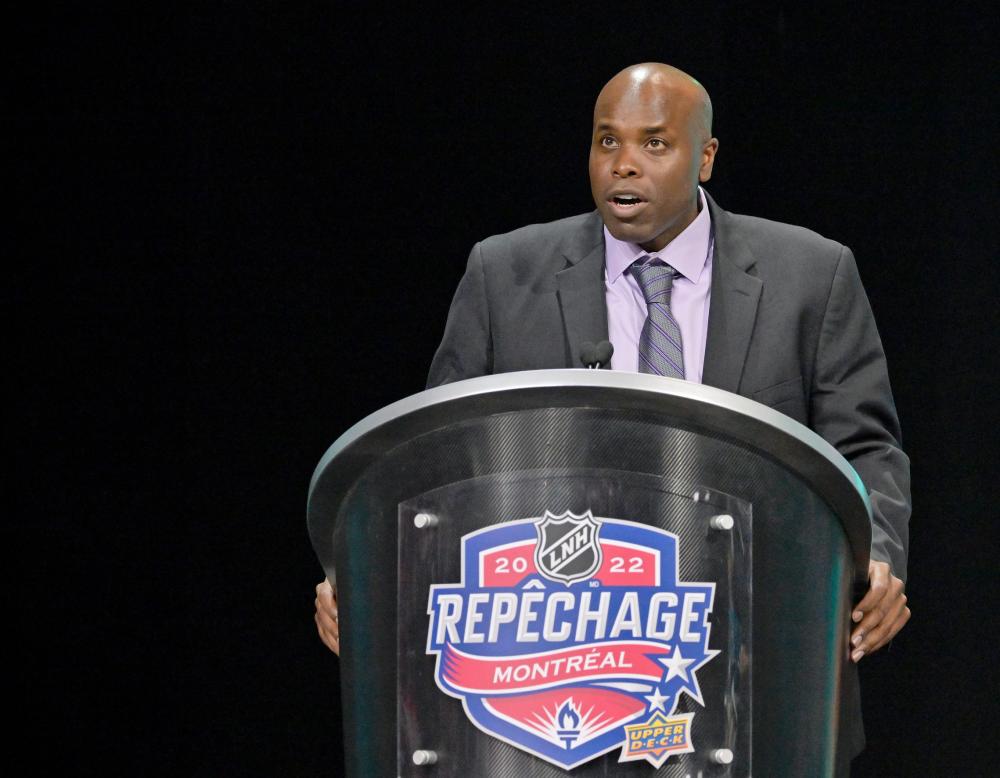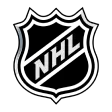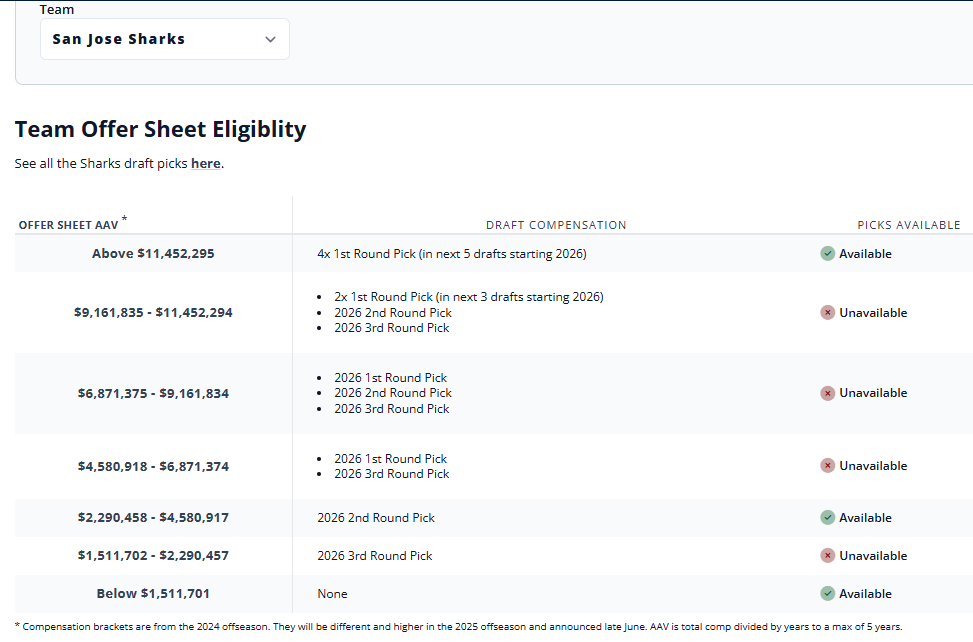NHL News
Cranking the Sharks into High Grier

Special for PuckPedia by Steve Werier, former Florida Panthers Assistant General Manager. Image © Eric Bolte-Imagn Images
In 2000, the Columbus Blue Jackets and Minnesota Wild joined (or re-joined) the NHL in an expansion draft where they alternated selections. The rules were against them. Existing clubs could protect virtually all their valued roster players, and they pretty much did. That said, opportunities existed, and mistakes were made. Columbus GM Doug Maclean cut side deals with the San Jose Sharks and Buffalo Sabres, receiving late round picks for promises not to select two goalies: Evgeni Nabokov & Dominik Hasek.
In 2017, the Vegas Golden Knights leveraged more complex expansion rules (and unforced errors by a rival GM that we shall not speak of) to negotiate their way to a Day 1 roster that made the Final that year. It took a lot of chutzpah.
In 2022, the Seattle Kraken struggled to equal Vegas (most clubs learned from their mistakes). Today’s Kraken’s roster resembles many others— decent veteran players on medium term/medium salary deals.
Which is to say, most of the time, even the brand new teams start - or quickly end up with - their share of contractual baggage. It would be easier to begin with a blank slate, a bunch of high value draft picks, multiple young superstars on entry level deals, and then be able to sign and trade for whoever you want. But that setup never happens, right?
Wrong. It’s shaping up to be the 2026 San Jose Sharks.
Building More Than a Roster
Earlier this month, Connor Bedard was sent home to bed early after earning a 10 minute misconduct during the third period of Chicago’s loss in San Jose. Around the same time, pictures appeared on social media showing Sharks rookies Will Smith and Macklin Celebrini staying up late having post-win slumber party in a hotel room with veteran teammate Tyler Toffoli. Bedard looked frustrated — he has for much of this season. The Baby Sharks look like they’re having a blast.
San Jose GM Mike Grier has quietly put on a masterclass in team-building, in both senses of the word. In a league where young players have more leverage than ever before, that matters more than ever before.
Let’s focus mostly on Grier’s salary cap and asset harvesting work here, but that stuff isn’t sufficient if good players don’t want to join - and stay - with your club. Dysfunction among management and/or coaches can derail an otherwise talented group (I’ve seen it). Conversely, there’s plenty of good externalities if you keep your side of the street clean. Credit for both always lies with the boss.
Grier deserves credit for hiring RyanWarsofsky as the youngest first time head coach in the league. If that didn’t work out, it would have been harder to defend than a coaching retread with a proven track record. Warsofsky seems to be working out; not well enough for the Sharks to be competitive, but that wasn’t a reasonable ask this year. He makes sure his young stars — Smith, Celebrini and William Eklund — get ample ice time and opportunities, and has generally played them with the best linemates available. When he speaks to the media he’s engaging and relatable. He seems like a guy Gen-Z players would like.
Couple that with signing Hall of Fame Good Guy Tyler Toffolli to a long term deal to ensure the young stars have a role model on and off the ice, and Grier’s off to a solid start in the culture department. That can’t be measured but it’s important.
*I think it will land them Marner*
Mastering the Trade Market
Now on to the roster moves.
In July 2022 when Grier was named GM, San Jose had wrapped up a 15 year run as a contender. Like this year’s Bruins, that meant a portfolio of legacy veteran contracts, depleted draft capital, and a modest prospect pool.
Grier’s Deadline work a few weeks ago bolstered that portfolio. Prior to the deadline he sent Mikael Granlund to Dallas for a 1st. Even better, he moved the found money that was Jake Walman (who a season prior Grier was paid a 2nd round pick to take off Detroit’s hands) to EDM for another 1st. I think as a rule we give too much credit for managers who get market returns for good players, but that’s not always a tap-in (look at Vancouver and Brock Boeser) and I think Grier outperformed expectations here.
He also traded Fabian Zetterlund to OTT for a 2nd. Zetterlund is a fairly young and useful player but I think a heuristic at this stage of the build like “monetize everything except foundational players” is totally fine.
Speaking of foundational young players, Grier added a potential one last summer in goalie Yaroslav Askarov, a 22 year old who was the 11th overall pick in the 2020 draft and is regarded by most around the league as a future high end #1. The acquisition cost was steep — a 1st round pick and a former 1st round pick (David Edstrom – 32nd in 2023) in exchange for a 3rd coming back. However, Grier took a solid step to replenishing that draft capital later in the season by moving Mackenzie Blackwood to Colorado for a 2nd after acquiring him from the Devils for a 6th last year.
These deadline moves followed some prior shrewd dealing by Grier. Soon after being named GM he got in front of Brent Burns’ inevitable decline by getting his long-term contract off the books in a trade with Carolina. He also acquired a 1st, a former 1st (Mukhamadullin – 20th in 2020), Zetterlund (which he turned into a 2nd) and other futures from New Jersey in exchange for Timo Meier. Thomas Hertl yielded another 1st from Vegas (plus Edstrom), while in perhaps his best work, Grier moved Erik Karlsson to Pittsburgh for a 1st and Granlund (who he just turned into another 1st).
The Cleanest Cap Sheet in the NHL
With those veterans all removed, the only one-way, non-buryable contracts on the books beyond 25-26 are Toffolli, Logan Couture (who’s on IR) and Barclay Goodrow (3.6M until 2027). Claiming Goodrow off waivers from Grier’s alma mater, the Rangers, was a mistake at the time and continues to be one now (he has 20 points in his last 145 games). However, the opportunity cost in the long run was minimal — the Sharks gave up nothing to claim him and will likely be shy of the cap ceiling for the duration of his deal. Chalk it up to a teachable moment (he’s not the first GM to overpay a familiar face from a prior gig).
So here we are. The Sharks are set up to have a near completely clean slate next summer and a surplus of draft capital to build around Celebrini, Smith, Eklund and Askarov.
Two Paths, Big Decisions
I think there’s two directions Grier can go from here.
The first is to fill out next year’s roster with a bunch of lower tier veteran free agent and cap dumps from other clubs, farm for picks at another deadline, and hope to end up with another lottery pick and a shot at Gavin McKenna in the 2026 Draft. That’s conservative. It could work. It’s boring.
The other direction is to go all in this summer and break open the competitive window right now, understanding that the best way to build around Celebrini & Smith is to add more players like Celebrini and Smith. To do that the Sharks could attack on two fronts: (1) sign a transformational free agent like Mitch Marner or Nikolaj Ehlers and (2) deploy an offer sheet with an AAV in the Wyatt Johnston range ($8M+) to lure an elite young player like JJ Peterka or Matthew Knies or a sneaky good RFA D in Winnipeg’s Dylan Samberg to start building out the back-end.
This latter strategy could work for the Sharks - they have infinite cap space and multiple first round picks in the next 2 drafts. An offer sheet with an AAV close to the 9.1M threshold would cost a 1st, 2nd and 3rd, which is a just a 3rd round pick more than the picks the Sharks added through he Jake Walman Trades alone. Provided Grier is confident that their rebuild will be far enough along that their 2026 1st won’t be lottery bound, that’s a completely digestible price to immediately acquire a player of that calibre. Toronto might have some trouble matching on Knies if they intend to re-sign Marner, and with all the turmoil in Buffalo it’s possible that a match for Peterka at a number close to 9M isn’t a foregone conclusion. The Sharks would need to reacquire their OWN 2026 3rd to extend a $9M offer sheet, but reacquiring their own pick didn’t slow down St. Louis last year.
Grier has set the Sharks up to have some exciting decisions to make. They’re earning that right, and depending on what they do, the Shark Tank (the building, not the strategy) could be the place to be sooner than later.
Steve Werier joined the Florida Panthers in 2014 and was Assistant General Manager from 2016 to 2017. He's currently the general counsel to a New York based tech venture company.









